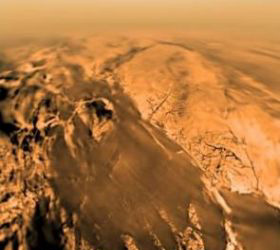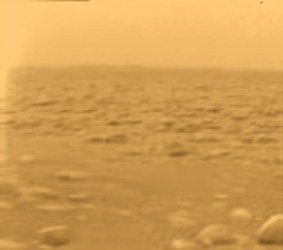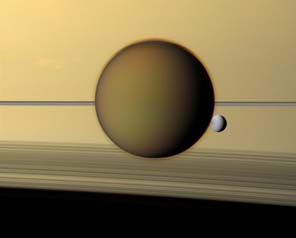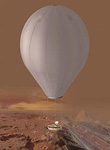|
|
Titan Moon Facts
Titan Facts
- Titan is the sixth moon in distance from Saturn.
- It is the largest of Saturn's moons and the second largest in the
solar system. - Titan has a diameter of 3,200 miles (5150 km) which is larger than Mercury and 50% larger than our own moon.
- If Titan orbited the sun instead of Saturn it would certainly be classed as a planet.
- It orbits around Saturn at a distance of 759,000 miles (1.2 million km) taking 16 days to complete one orbit of the planet.
- Titan is the only moon in the solar system with a significant
atmosphere. - It is the only body in the solar system apart from Earth known to have large areas of liquid on its surface.
- Like water on Earth methane exists on Titan as a liquid, solid and a gas. Rain falls on Titan in the form of liquid methane.
- Atmospheric pressure on Titan is only 1.6 greater of that on Earth.
Surface, Atmosphere & Temperature
Titan's Surface
A lack of crater impacts on Titan indicates a surface which has been modified by flowing liquids. Standing lakes of liquid methane
exist on the surface as well as dry river valleys. There is also evidence for cryovolcanism, where instead of spewing molten rock,
volcanoes erupt with water and ammonia.
Titan's Atmosphere
Titan has an extremely thick atmosphere and like Earth it consists mainly of nitrogen, 95% in the case of Titan compared to 78% on Earth. The remaining 5% is made up of
methane (3%) and hydrogen (2%).
Titan's Temperature
The average temperature on Titan's surface is -179C (-290F).
The moon with an atmosphere
 Natural color image of Titan taken by Cassini, the moon is covered by a thick atmosphere
Natural color image of Titan taken by Cassini, the moon is covered by a thick atmosphere
Titan from above (Huygens probe)
 Image of Titan created by the Huygens probe as it descended onto the moon
Image of Titan created by the Huygens probe as it descended onto the moon
Titan Origin of Name and Life

Artist's impression of a methane lake on Titan
Origin of Name
Christiaan Huygens named the moon Saturnas Luna (Saturn's moon) after his discovery in 1655. After Giovanni Domenico Cassini discovered four more moons between
1673 and 1686 it was renamed Saturn IV (Saturn 4) as it was then thought to be the fourth moon. In 1847 John Herschel, son of
William Herschel, suggested that
Saturn's moons be named after the Titans, a race of powerful deities from Greek mythology. He
suggested the moon be simply named Titan.
Life on Titan
It is believed the atmosphere of early Earth was very similar in composition to what we see
on Titan today. As a result Titan is often compared to a frozen version of primordial Earth.
As methane is a substitute for water on Titan some forms of methanogenic lifeforms could exist in the harsh conditions.
Another theory is that liquid ammonia oceans could be present deep under the surface which could provide an environment for microbial life
to exist.
Images
Titan's surface (Huygen's Probe)


Lake on Titan (Artist's Impression)


Titan with Saturn's 4th largest moon Dione


Future and Past Missions to Titan
Titan Saturn System Mission
 Launch: 2020
Launch: 2020Agency: NASA/ESA (Europe)
TSSM is an ambitious joint venture between NASA and the ESA to explore Titan. The mission consists of an orbiter, a hot air balloon (pictured left) which will float
in Titan's clouds and a lake lander which will study the bodies of liquid methane found on the surface.
Cassini-Huygens
 Launch: October 1997
Launch: October 1997Arrival: October 2004
Agency: NASA/ESA (Europe)
Until the arrival of this spacecraft little was known about Titan, Cassini-Huygens changed that dramatically.
Numerous flybys and a successful landing of the Huygens Probe on Titan has revealed vast liquid methane lakes, wind driven sand dunes
and the possible presence of deep liquid water-ammonia oceans.
Voyager 1 and 2
 Launch: August-September 1977
Launch: August-September 1977Arrival: November 1980-August 1981
Agency: NASA
Voyager 1 made a successful close flyby of Titan but unfortunately did not possess the necessary equipment to see past its thick atmosphere.
Voyager 2 passed at a much greater distance so provided little new detail. NASA had the option of sending Voyager 2 to take a much closer look at Titan but instead decided
to steer the craft towards Uranus and Neptune.
|
|
